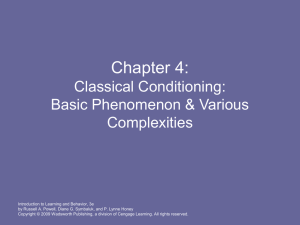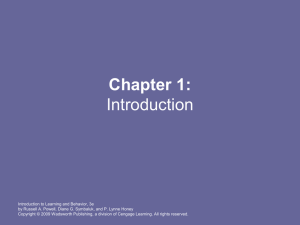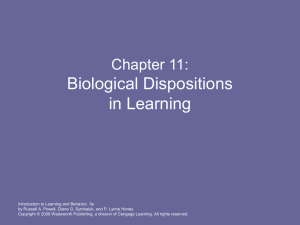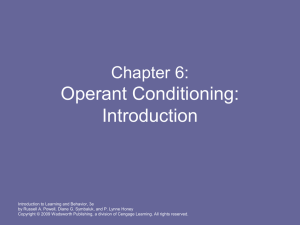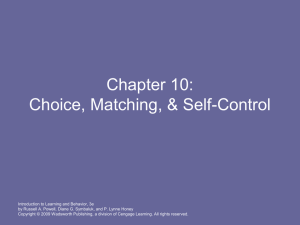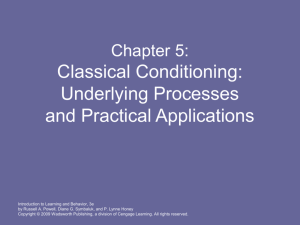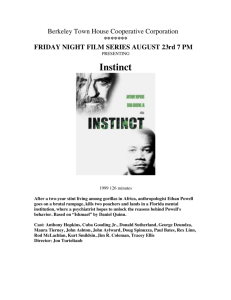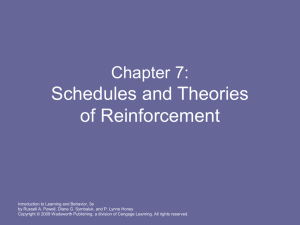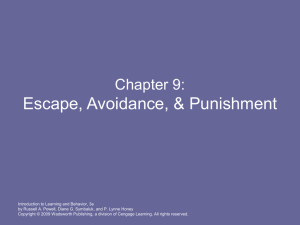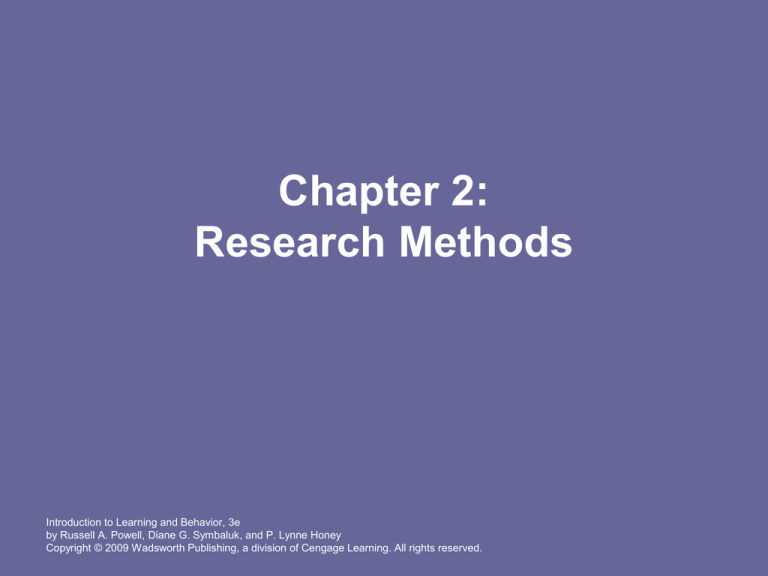
Chapter 2:
Research Methods
Introduction to Learning and Behavior, 3e
by Russell A. Powell, Diane G. Symbaluk, and P. Lynne Honey
Copyright © 2009 Wadsworth Publishing, a division of Cengage Learning. All rights reserved.
Behavioral Research
• Begin by developing a hypothesis or by
deciding on a specific area of interest
• Employ a research method
– naturalistic observation
– case studies
– control group designs
– single-subject designs
• Collect behavioral data
Introduction to Learning and Behavior, 3e
by Russell A. Powell, Diane G. Symbaluk, and P. Lynne Honey
Copyright © 2009 Wadsworth Publishing, a division of Cengage Learning. All rights reserved.
Variables
• characteristics of a person, place, or thing
that can change (vary) over time or from
one situation to another.
– Examples: height, weight, marital status, age,
hair color
Introduction to Learning and Behavior, 3e
by Russell A. Powell, Diane G. Symbaluk, and P. Lynne Honey
Copyright © 2009 Wadsworth Publishing, a division of Cengage Learning. All rights reserved.
Independent Variable
• systematically varies across different conditions
in an experiment.
• They are manipulated by the experimenter.
• Example:
– Research Question: Does the size of a reward affect
the efficiency of learning?
– Independent Variable: the number of food pellets the
rats in each group receive when they reach the goal
Introduction to Learning and Behavior, 3e
by Russell A. Powell, Diane G. Symbaluk, and P. Lynne Honey
Copyright © 2009 Wadsworth Publishing, a division of Cengage Learning. All rights reserved.
Dependent Variable
• the aspect of an experiment that is allowed to
vary freely to see if it is affected by changes in
the independent variable.
• They are measured by the experimenter.
• Example:
– Research Question: Does the size of a reward affect
the efficiency of learning?
– Dependent Variable: the total number of errors the rat
makes while trying to find its way to the goal
Introduction to Learning and Behavior, 3e
by Russell A. Powell, Diane G. Symbaluk, and P. Lynne Honey
Copyright © 2009 Wadsworth Publishing, a division of Cengage Learning. All rights reserved.
Functional Relationship
• the relationship between changes in an
independent variable and changes in a
dependent variable.
• It can also be thought of as a cause-andeffect relationship.
• The behavioral researchers are interested
in determining the functional relationship
between stimulus and responses.
Introduction to Learning and Behavior, 3e
by Russell A. Powell, Diane G. Symbaluk, and P. Lynne Honey
Copyright © 2009 Wadsworth Publishing, a division of Cengage Learning. All rights reserved.
Stimulus
• any event that can potentially influence
behavior.
• Examples:
– red light
– food
• Events both outside the skin and inside
the skin can influence our behavior.
Introduction to Learning and Behavior, 3e
by Russell A. Powell, Diane G. Symbaluk, and P. Lynne Honey
Copyright © 2009 Wadsworth Publishing, a division of Cengage Learning. All rights reserved.
Response
• a particular instance of a behavior.
• Examples:
– press the brake
– salivating
• The response of one organism can act as a
stimulus that influences the response of another
organism.
• Example:
– when one rat bites another
Introduction to Learning and Behavior, 3e
by Russell A. Powell, Diane G. Symbaluk, and P. Lynne Honey
Copyright © 2009 Wadsworth Publishing, a division of Cengage Learning. All rights reserved.
Overt Behavior
• is behavior that has the potential for being
directly observed by an individual other
than the one performing the behavior.
• Behaviorists traditionally have tended to
emphasize the study of overt behavior.
• Examples:
– response of saying hello
– a rat’s response of pressing a lever
Introduction to Learning and Behavior, 3e
by Russell A. Powell, Diane G. Symbaluk, and P. Lynne Honey
Copyright © 2009 Wadsworth Publishing, a division of Cengage Learning. All rights reserved.
Covert Behavior
• behavior that can be perceived only by the
person performing the behavior.
• Skinner maintained that internal events such as
thoughts, feelings, and even sensory
experiences should be classified as behaviors.
• Examples:
– Feeling anxiety
– Visualizing how your date will go
Introduction to Learning and Behavior, 3e
by Russell A. Powell, Diane G. Symbaluk, and P. Lynne Honey
Copyright © 2009 Wadsworth Publishing, a division of Cengage Learning. All rights reserved.
Appetitive Stimulus
• an event that an organism will seek out.
• Examples:
– Food when we are hungry
– Water when we are thirsty
• These events are not always “pleasant”.
• Examples:
– Smokers seek out cigarettes even though
they feel smoking is disgusting.
Introduction to Learning and Behavior, 3e
by Russell A. Powell, Diane G. Symbaluk, and P. Lynne Honey
Copyright © 2009 Wadsworth Publishing, a division of Cengage Learning. All rights reserved.
Aversive Stimulus
• an event that an organism will avoid.
• Examples:
– Extreme heat
– Electric shock
• These events are not always “unpleasant”.
• Example:
– Some people avoid being loved even though
they believe being loved is wonderful.
Introduction to Learning and Behavior, 3e
by Russell A. Powell, Diane G. Symbaluk, and P. Lynne Honey
Copyright © 2009 Wadsworth Publishing, a division of Cengage Learning. All rights reserved.
Establishing Operation
• a procedure that affects the appetitiveness
or aversiveness of a stimulus.
• Appetitiveness or aversiveness of an
event depends on a particular state or
condition.
• Deprivation and satiation are two types of
establishing operations.
Introduction to Learning and Behavior, 3e
by Russell A. Powell, Diane G. Symbaluk, and P. Lynne Honey
Copyright © 2009 Wadsworth Publishing, a division of Cengage Learning. All rights reserved.
Deprivation
• the prolonged absence of an event that
tends to increase the appetitiveness of
that event.
• Examples:
– Going without food, television, or social
contact for a long period of time
• There are exceptions.
• Example: anorexia nervosa
Introduction to Learning and Behavior, 3e
by Russell A. Powell, Diane G. Symbaluk, and P. Lynne Honey
Copyright © 2009 Wadsworth Publishing, a division of Cengage Learning. All rights reserved.
Satiation
• the prolonged exposure to an event, which
tends to decrease the appetitiveness of
that event.
• Examples:
– Eating a large meal
– Listening to the same music too many times
• There are exceptions.
• Example: anorexia nervosa
Introduction to Learning and Behavior, 3e
by Russell A. Powell, Diane G. Symbaluk, and P. Lynne Honey
Copyright © 2009 Wadsworth Publishing, a division of Cengage Learning. All rights reserved.
Contiguity
• means closeness or nearness.
• Temporal contiguity is the extent to which events
occur close together in time.
– Example: tantrum, followed immediately by candy
• Spatial contiguity is the extent to which events
are situated close to each other in space.
– Example: sound of the knock close to the door
Introduction to Learning and Behavior, 3e
by Russell A. Powell, Diane G. Symbaluk, and P. Lynne Honey
Copyright © 2009 Wadsworth Publishing, a division of Cengage Learning. All rights reserved.
Contingency
• a predictive relationship between two
events.
• The occurrence of one event predicts the
probable occurrence of another.
• Example:
– a rat receives a food pellet whenever it
presses a lever
– a child receives a big balloon every time she
goes to the dentist
Introduction to Learning and Behavior, 3e
by Russell A. Powell, Diane G. Symbaluk, and P. Lynne Honey
Copyright © 2009 Wadsworth Publishing, a division of Cengage Learning. All rights reserved.
Behavioral Definitions
• To study the effects of certain variables on a
behavior, we must properly define the behavior.
• The definition must refer to some observable
aspect of the individual’s behavior and be clearly
defined.
• Examples:
– Define yelling as a loud vocalization that continues for
more than 5 seconds and can be heard outside a
closed door – rather than defining angry behavior.
Introduction to Learning and Behavior, 3e
by Russell A. Powell, Diane G. Symbaluk, and P. Lynne Honey
Copyright © 2009 Wadsworth Publishing, a division of Cengage Learning. All rights reserved.
Rate of Response
• the frequency with which a response occurs in a
certain period of time.
• This method of measurement is most
appropriate when the response is of brief
duration, with a well-defined start and finish.
• Example:
– number of cigarettes smoked per day
• A cumulative recorder is a classic device that
measures the total number of responses over
time and provides a graphic depiction of the rate
of behavior.
Introduction to Learning and Behavior, 3e
by Russell A. Powell, Diane G. Symbaluk, and P. Lynne Honey
Copyright © 2009 Wadsworth Publishing, a division of Cengage Learning. All rights reserved.
Cumulative Record
Introduction to Learning and Behavior, 3e
by Russell A. Powell, Diane G. Symbaluk, and P. Lynne Honey
Copyright © 2009 Wadsworth Publishing, a division of Cengage Learning. All rights reserved.
Intensity
• the force or magnitude of the behavior.
• Example:
Tone: Food → Salivation
Tone → Salivation
– measured as the amount (magnitude) of
saliva produced whenever the tone was
sounded by itself.
Introduction to Learning and Behavior, 3e
by Russell A. Powell, Diane G. Symbaluk, and P. Lynne Honey
Copyright © 2009 Wadsworth Publishing, a division of Cengage Learning. All rights reserved.
Duration
• the length of time that an individual repeatedly or
continuously performs a certain behavior.
• This measure is appropriate when either
increasing or decreasing the length of time the
behavior occurs.
• Example:
– Length of time a student studies
• This measure is problematic because it doesn’t
indicate the quality of the behavior.
Introduction to Learning and Behavior, 3e
by Russell A. Powell, Diane G. Symbaluk, and P. Lynne Honey
Copyright © 2009 Wadsworth Publishing, a division of Cengage Learning. All rights reserved.
Speed
• a measure of how quickly or slowly a
behavior occurs, or the rapidity with which
one progresses through some type of
distance.
• Example:
– length of time for a rat to run through a maze
Introduction to Learning and Behavior, 3e
by Russell A. Powell, Diane G. Symbaluk, and P. Lynne Honey
Copyright © 2009 Wadsworth Publishing, a division of Cengage Learning. All rights reserved.
Latency
• the length of time required for the behavior
to begin.
• Examples:
– how soon the dog begins salivating after it
hears the tone
– how soon the children make their bed after
being told to
Introduction to Learning and Behavior, 3e
by Russell A. Powell, Diane G. Symbaluk, and P. Lynne Honey
Copyright © 2009 Wadsworth Publishing, a division of Cengage Learning. All rights reserved.
Interval Recording
• the measurement of whether or not a behavior
occurs within a series of continuous intervals.
• The researcher does not have to record every
single response.
• Example:
– measure the percentage of intervals during which at
least one aggressive incident occurred
– to do this, record whether or not an incident occurred
within each successive 10-minute interval
Introduction to Learning and Behavior, 3e
by Russell A. Powell, Diane G. Symbaluk, and P. Lynne Honey
Copyright © 2009 Wadsworth Publishing, a division of Cengage Learning. All rights reserved.
Time-Sample Recording
• measures whether or not a behavior
occurs within a series of discontinuous
intervals
• Example:
– record whether at least one aggressive
incident occurred during a 10-minute interval
at the start of each half-hour
Introduction to Learning and Behavior, 3e
by Russell A. Powell, Diane G. Symbaluk, and P. Lynne Honey
Copyright © 2009 Wadsworth Publishing, a division of Cengage Learning. All rights reserved.
Topography
• measure the physical form of the behavior.
• Examples:
– how the rat presses the lever
– how the child gets dressed
Introduction to Learning and Behavior, 3e
by Russell A. Powell, Diane G. Symbaluk, and P. Lynne Honey
Copyright © 2009 Wadsworth Publishing, a division of Cengage Learning. All rights reserved.
Number of Errors
• measures any behavior in which
responses can be categorized as right or
wrong.
• Examples:
– the number of errors a student makes on an
exam
– the number of wrong turns a rat takes before
it finds its way through a maze
Introduction to Learning and Behavior, 3e
by Russell A. Powell, Diane G. Symbaluk, and P. Lynne Honey
Copyright © 2009 Wadsworth Publishing, a division of Cengage Learning. All rights reserved.
Descriptive Research
• involves simply describing the behavior and the
situation within which it occurs.
• This research does not involve the manipulation
of any variables.
• Naturalistic observation involves the systematic
observation and recording of behavior in its
natural environment.
– Example: Jane Goodall’s systematic study of
chimpanzee behavior in the wild
• The naturalistic approach is excellent for gaining
rich, detailed information.
Introduction to Learning and Behavior, 3e
by Russell A. Powell, Diane G. Symbaluk, and P. Lynne Honey
Copyright © 2009 Wadsworth Publishing, a division of Cengage Learning. All rights reserved.
Descriptive Research, continued
• The case study approach involves the
intensive examination of one or a few
individuals.
• These can be done in natural settings or
more structured settings.
• Example:
– studying individuals who have suffered
neurological damage or relatively rare
psychological disorders
Introduction to Learning and Behavior, 3e
by Russell A. Powell, Diane G. Symbaluk, and P. Lynne Honey
Copyright © 2009 Wadsworth Publishing, a division of Cengage Learning. All rights reserved.
Experimental Research
• experiments to discover cause-and-effect
relationships between environmental
events and behavior.
• One or more independent variables are
systematically varied to determine their
effect on a dependent variable.
• The two main types are control group
designs and single-subject designs.
Introduction to Learning and Behavior, 3e
by Russell A. Powell, Diane G. Symbaluk, and P. Lynne Honey
Copyright © 2009 Wadsworth Publishing, a division of Cengage Learning. All rights reserved.
Control Group Designs
• individuals are randomly assigned to either an
experimental group or a control group
• individuals assigned to the experimental group
are exposed to a certain manipulation or
treatment
• those assigned to the control group are not
exposed to it
• Example:
– the experimental rats receive food, while the control
rats do not
Introduction to Learning and Behavior, 3e
by Russell A. Powell, Diane G. Symbaluk, and P. Lynne Honey
Copyright © 2009 Wadsworth Publishing, a division of Cengage Learning. All rights reserved.
Factorial Design
• control group designs that examine the
interaction of more than one independent
variable.
• Example:
– We might rerun the experiment (free food
versus no food) with groups of old rats,
middle-aged rats, and young rats.
– This is a 2 × 3 factorial design.
– Interaction effects give us a much finer
understanding of the variables.
Introduction to Learning and Behavior, 3e
by Russell A. Powell, Diane G. Symbaluk, and P. Lynne Honey
Copyright © 2009 Wadsworth Publishing, a division of Cengage Learning. All rights reserved.
Example Factorial Design
Introduction to Learning and Behavior, 3e
by Russell A. Powell, Diane G. Symbaluk, and P. Lynne Honey
Copyright © 2009 Wadsworth Publishing, a division of Cengage Learning. All rights reserved.
Comparative Design
• control group design in which different species
are independent variables.
• It is used to test an evolutionary hypothesis.
• Comparative designs can be simple or factorial.
• Example:
– Research Question: Do rats deal with small, enclosed
environments better than dogs?
– Examine: how quickly dogs and rats learn to find a
target in a complex maze versus a large open area
Introduction to Learning and Behavior, 3e
by Russell A. Powell, Diane G. Symbaluk, and P. Lynne Honey
Copyright © 2009 Wadsworth Publishing, a division of Cengage Learning. All rights reserved.
Benefits of Control Group Designs
• You can assess the general effects of certain
variables.
• You can determine cause-and-effects.
• You can be fairly confident that differences
between groups in performance are the result of
differences in the independent variable.
• Various characteristics of the subjects in each
group are likely to be evenly distributed.
Introduction to Learning and Behavior, 3e
by Russell A. Powell, Diane G. Symbaluk, and P. Lynne Honey
Copyright © 2009 Wadsworth Publishing, a division of Cengage Learning. All rights reserved.
Limitations of Control Group
Designs
• They require a large number of subjects.
• They are not well suited for investigating the
effect of a certain treatment on a particular
individual.
• They focus on the average performance of all
subjects in each group.
• Results are often analyzed and interpreted only
at the end of the experiment.
• Species can differ in more ways than just their
learning capacity or style (comparative designs).
Introduction to Learning and Behavior, 3e
by Russell A. Powell, Diane G. Symbaluk, and P. Lynne Honey
Copyright © 2009 Wadsworth Publishing, a division of Cengage Learning. All rights reserved.
Single-Subject Designs
• require only one or a few subjects to conduct an
entire experiment.
• The problem of generalizability is typically
solved by running the study with more than one
subject.
• If we find the same pattern of results for all of the
subjects submitted to these procedures, the
findings are likely to have good generality.
• There are several types.
Introduction to Learning and Behavior, 3e
by Russell A. Powell, Diane G. Symbaluk, and P. Lynne Honey
Copyright © 2009 Wadsworth Publishing, a division of Cengage Learning. All rights reserved.
Simple-Comparison Design
• Behavior in a baseline condition is compared to
behavior in a treatment condition.
• The baseline is the normal frequency of the
behavior that occurs before some intervention.
– The baseline period is often called the A phase.
– The treatment period is called the B phase.
• This design does not control for the possibility
that some other event that occurred at the same
time as the treatment could have caused the
change in the behavior.
Introduction to Learning and Behavior, 3e
by Russell A. Powell, Diane G. Symbaluk, and P. Lynne Honey
Copyright © 2009 Wadsworth Publishing, a division of Cengage Learning. All rights reserved.
Example
• Cory wonders if he might be able to cut down on
smoking by punishing himself.
• He needs to take a baseline measure of the
number of cigarettes he typically smokes each
day.
• Cory should continue the baseline period until
the behavior stabilizes.
• He should then institute the self-punishment
procedure for several days.
• He should measure the number of cigarettes he
smokes during the intervention period.
Introduction to Learning and Behavior, 3e
by Russell A. Powell, Diane G. Symbaluk, and P. Lynne Honey
Copyright © 2009 Wadsworth Publishing, a division of Cengage Learning. All rights reserved.
Cory’s Simple-Comparison Design
Results
Introduction to Learning and Behavior, 3e
by Russell A. Powell, Diane G. Symbaluk, and P. Lynne Honey
Copyright © 2009 Wadsworth Publishing, a division of Cengage Learning. All rights reserved.
Reversal Design
• a type of single-subject design that involves
repeated alternations between a baseline period
and a treatment period.
• If the behavior changes each time the treatment
is instituted and later withdrawn, then a
functional relationship has been demonstrated.
• It is ideal for determining the effectiveness of a
behavioral intervention for one person.
• Statistical tests are not needed.
• Example:
– Cory would repeat the baseline period and then the
treatment period.
Introduction to Learning and Behavior, 3e
by Russell A. Powell, Diane G. Symbaluk, and P. Lynne Honey
Copyright © 2009 Wadsworth Publishing, a division of Cengage Learning. All rights reserved.
Cory’s Reversal Design Results
Introduction to Learning and Behavior, 3e
by Russell A. Powell, Diane G. Symbaluk, and P. Lynne Honey
Copyright © 2009 Wadsworth Publishing, a division of Cengage Learning. All rights reserved.
More Than One Treatment
• A reversal design can be used to assess
the effectiveness of more than one
treatment.
• Example:
– Cory can use punishment and reinforcement
as two different treatments to reduce his
smoking.
Introduction to Learning and Behavior, 3e
by Russell A. Powell, Diane G. Symbaluk, and P. Lynne Honey
Copyright © 2009 Wadsworth Publishing, a division of Cengage Learning. All rights reserved.
Cory’s Results With Two
Treatments
Introduction to Learning and Behavior, 3e
by Russell A. Powell, Diane G. Symbaluk, and P. Lynne Honey
Copyright © 2009 Wadsworth Publishing, a division of Cengage Learning. All rights reserved.
Limitations of Reversal Designs
• The behavior must revert to its original
baseline frequency when the treatment is
withdrawn.
• Some treatments are intended to produce
long-lasting effects.
• It may be ethically inappropriate to remove
a treatment once some improvement has
been obtained.
Introduction to Learning and Behavior, 3e
by Russell A. Powell, Diane G. Symbaluk, and P. Lynne Honey
Copyright © 2009 Wadsworth Publishing, a division of Cengage Learning. All rights reserved.
Multiple Baseline Design
• a treatment is instituted at successive points in time for
two or more persons, settings, or behaviors.
• Multiple-Baseline-Across-Persons
– measure the behavior of each person at baseline
– measure the behavior of each person at treatment
• Multiple-Baseline-Across-Settings
– measure the behavior in each setting at baseline
– measure the behavior in each setting at treatment
• Multiple-Baseline-Across-Behaviors
– measure each behavior at baseline
– measure each behavior at treatment
Introduction to Learning and Behavior, 3e
by Russell A. Powell, Diane G. Symbaluk, and P. Lynne Honey
Copyright © 2009 Wadsworth Publishing, a division of Cengage Learning. All rights reserved.
Benefits & Limitations of Multiple
Baseline Designs
• This design is appropriate when the treatment is
likely to produce a permanent change in
behavior, or when it may be unethical to
withdraw the treatment.
• You need more than one person, setting, or
behavior to which the treatment can be applied.
• The treatment effect might generalize across the
different settings or behaviors occurring before
the intervention is instituted.
Introduction to Learning and Behavior, 3e
by Russell A. Powell, Diane G. Symbaluk, and P. Lynne Honey
Copyright © 2009 Wadsworth Publishing, a division of Cengage Learning. All rights reserved.
Criterion-Changing Design
• The effect of the treatment is demonstrated by
how closely the behavior matches a criterion that
is systematically altered.
• It is appropriate for situations in which the
behavior is intended to change gradually.
• It can be greatly strengthened by including
periods in which the criterion suddenly changes
in the opposite direction.
• Example:
– Cory decides to gradually reduce his smoking
behavior and sets a certain criterion for an allowable
number of cigarettes.
Introduction to Learning and Behavior, 3e
by Russell A. Powell, Diane G. Symbaluk, and P. Lynne Honey
Copyright © 2009 Wadsworth Publishing, a division of Cengage Learning. All rights reserved.
Cory’s Changing Criterion Design
Results
Introduction to Learning and Behavior, 3e
by Russell A. Powell, Diane G. Symbaluk, and P. Lynne Honey
Copyright © 2009 Wadsworth Publishing, a division of Cengage Learning. All rights reserved.
Advantages of Using Animals in
Research
• Researchers have the ability to control
their genetic makeup.
• Researchers have the ability to control
their learning history.
• Researchers have the ability to control
their experimental environment.
• Some research cannot ethically be
conducted with humans.
Introduction to Learning and Behavior, 3e
by Russell A. Powell, Diane G. Symbaluk, and P. Lynne Honey
Copyright © 2009 Wadsworth Publishing, a division of Cengage Learning. All rights reserved.
Arguments Against Using Animals
in Research
• The findings from animal research
necessarily have limited applicability to
humans.
• It is morally wrong.
• Animals should have rights similar to
humans.
Introduction to Learning and Behavior, 3e
by Russell A. Powell, Diane G. Symbaluk, and P. Lynne Honey
Copyright © 2009 Wadsworth Publishing, a division of Cengage Learning. All rights reserved.
Summary
• Behavioral research involves the manipulation
and measurement of variables.
• Independent variable vs. dependent variable
• Appetitive stimuli vs. aversive stimuli
• Establishing operations are conditions that affect
the appetitiveness or aversiveness of an event.
• Deprivation vs. satiation
• Contingency is when the occurrence of one
event predicts the likely occurrence of another.
Introduction to Learning and Behavior, 3e
by Russell A. Powell, Diane G. Symbaluk, and P. Lynne Honey
Copyright © 2009 Wadsworth Publishing, a division of Cengage Learning. All rights reserved.
Summary, continued
• Researchers need to determine the most
appropriate way to measure changes in
behavior:
–
–
–
–
–
–
–
–
–
Rate of response
Intensity
Duration
Speed
Latency
Interval recording
Time-sample recording
Topography
Number of Errors
Introduction to Learning and Behavior, 3e
by Russell A. Powell, Diane G. Symbaluk, and P. Lynne Honey
Copyright © 2009 Wadsworth Publishing, a division of Cengage Learning. All rights reserved.
Summary, continued
• Researchers need to determine the most
appropriate method for conducting research.
• Two descriptive methods are naturalistic
observation and the case study approach.
• They do not demonstrate causality.
• Experimental methods demonstrate causal
relationships.
– Control group designs - simple, factorial, comparative
– Single-subject designs - simple-comparison, reversal,
multiple-baseline, and changing-criterion
Introduction to Learning and Behavior, 3e
by Russell A. Powell, Diane G. Symbaluk, and P. Lynne Honey
Copyright © 2009 Wadsworth Publishing, a division of Cengage Learning. All rights reserved.
Summary, continued
• Advantages of using animals as subjects in
behavioral research include:
–
–
–
–
enhanced control over learning history
enhanced control over genetic background
enhanced control over experimental environment
animals can be used in ethically questionable studies
• Disadvantages of using animals are:
– the possibility that findings may be limited
– animals have the same rights as humans
Introduction to Learning and Behavior, 3e
by Russell A. Powell, Diane G. Symbaluk, and P. Lynne Honey
Copyright © 2009 Wadsworth Publishing, a division of Cengage Learning. All rights reserved.

